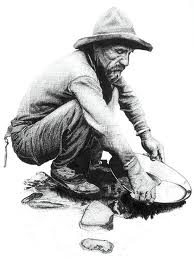 Miners who would strike it rich in the Gold Rush would make Evergreen their home in the later half of the 1800’s. The discovery of gold would hasten California’s Statehood and spur immigration to the Golden State. Evergreen had a huge hand in bringing California to Statehood. Businessman, Orchardist, winemaker and French immigrant, Luis Pellier, would become the father of California’s Fruit Industry when noting the high price of fruit while he was panning for gold. With a little success gold panning and a little luck being a farmer from France, he managed to create his own gold. Henry W. Coe, for whom the park is named after, struck it rich importing mining equipment through the Gold Rush, enabling him to invest in such a large Evergreen property after pulling stakes up from Willow Glen.
Miners who would strike it rich in the Gold Rush would make Evergreen their home in the later half of the 1800’s. The discovery of gold would hasten California’s Statehood and spur immigration to the Golden State. Evergreen had a huge hand in bringing California to Statehood. Businessman, Orchardist, winemaker and French immigrant, Luis Pellier, would become the father of California’s Fruit Industry when noting the high price of fruit while he was panning for gold. With a little success gold panning and a little luck being a farmer from France, he managed to create his own gold. Henry W. Coe, for whom the park is named after, struck it rich importing mining equipment through the Gold Rush, enabling him to invest in such a large Evergreen property after pulling stakes up from Willow Glen.
A little known fact is that the Town of Evergreen would be that it is built up around active, productive mines. Tracking down these mines would be a little bit of a dig, but mining was a big deal for two distinct periods of time in Evergreen’s history. Mercury and Quicksilver are in the foundation of San Jose’s History, so much so that newspaper is called the Mercury News.
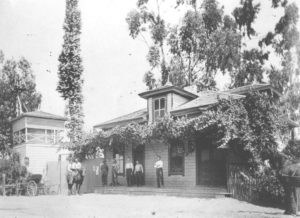 One of the first businesses ever opened in Evergreen was the Kettmann Saloon. Andrew Kettmann’s establishment was located on San Felipe Road in Downtown Evergreen, just North of the historic Smith family homes and businesses. The turn of the 20th century watering hole was frequented by miners up until Prohibition. The inebriated patrons would stumble off to kiss under the bridges of creek crossings nearby Cadwallader neighborhood by Keaton Loop. Prohibition brought the business under and San Felipe Road would be rerouted.
One of the first businesses ever opened in Evergreen was the Kettmann Saloon. Andrew Kettmann’s establishment was located on San Felipe Road in Downtown Evergreen, just North of the historic Smith family homes and businesses. The turn of the 20th century watering hole was frequented by miners up until Prohibition. The inebriated patrons would stumble off to kiss under the bridges of creek crossings nearby Cadwallader neighborhood by Keaton Loop. Prohibition brought the business under and San Felipe Road would be rerouted.
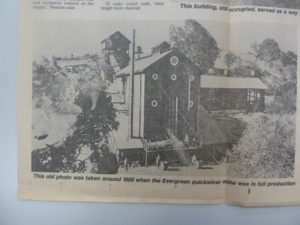 H. R. Bradford would eventually come to own the mining prospect and property in the 1890’s. Mr. Hector R. Bradford came from a mining family and one with political interests. Father, F. W. Farnsworth and once Governor of Massachusetts and descendants of Mayflower passangers, would move the family out West to California in 1884. Eldest son H. R. was only nine years old and sweeping around mine shafts as child. As an adult, H. R. Bradford would accumulate mining interests across California, but especially adored his Evergreen holding. He and partner J. Treadwell would own and operate the Silver Creek Mining Company. His business acumen was something to be admired.
H. R. Bradford would eventually come to own the mining prospect and property in the 1890’s. Mr. Hector R. Bradford came from a mining family and one with political interests. Father, F. W. Farnsworth and once Governor of Massachusetts and descendants of Mayflower passangers, would move the family out West to California in 1884. Eldest son H. R. was only nine years old and sweeping around mine shafts as child. As an adult, H. R. Bradford would accumulate mining interests across California, but especially adored his Evergreen holding. He and partner J. Treadwell would own and operate the Silver Creek Mining Company. His business acumen was something to be admired.
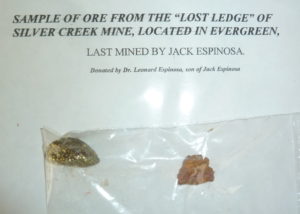 In 1895, a close examination of the flooding and mines was made and Silver Creek mines began delivering pay ore. Silver Creek mines was producers of quicksilver, mercury and cinnabar.
In 1895, a close examination of the flooding and mines was made and Silver Creek mines began delivering pay ore. Silver Creek mines was producers of quicksilver, mercury and cinnabar.
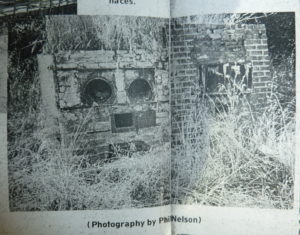 Mr. H. R. Bradford must have heard about furnaces like this at the mining prospect before making his decision about the Silver Creek acquisition. Quicksilver Mining would require lots of timber to fuel the furnaces. Evergreen had plenty of orchards pulling trees and natural oak trees. Bradford’s property in Evergreen was huge.
Mr. H. R. Bradford must have heard about furnaces like this at the mining prospect before making his decision about the Silver Creek acquisition. Quicksilver Mining would require lots of timber to fuel the furnaces. Evergreen had plenty of orchards pulling trees and natural oak trees. Bradford’s property in Evergreen was huge.
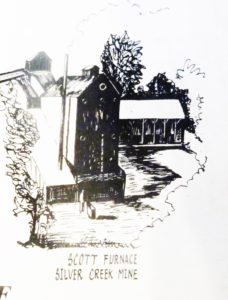 Silver Creek Mines and the Mining Company would be named after Silver Creek, a spring and creek which lay nearby the site of the mines. In fact, this mine is located directly Southeast from Silver Creek Valley Country Club, and you know you’re wicked close when you’re along the backside of the Country Club and get to the Creek. The mine now sits with the Espinosa family for some years now.
Silver Creek Mines and the Mining Company would be named after Silver Creek, a spring and creek which lay nearby the site of the mines. In fact, this mine is located directly Southeast from Silver Creek Valley Country Club, and you know you’re wicked close when you’re along the backside of the Country Club and get to the Creek. The mine now sits with the Espinosa family for some years now.
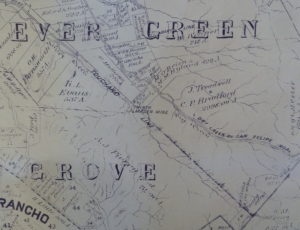 These mines in Evergreen, however, were preexisting. Bradford purchased historic cinnabar mines that were dormant and flooded for 25 years. These mines would be 5 miles North of the Almaden Mines. Their original name were the North Almaden Mines when it was owned by A. J. Piercy. Heir E. M. Piercy would sell to Bradford. Before the North Almaden Mining Company extracted cinnabar ore, it was known as the Adams Mine. The Comstock Panic would bring the mines to a halt in the 1860’s. The Comstock Panic brought to light poor money management and stock dealings in the mining industries in 1865. True interests and dividends were not being distributed properly. New Almaden would halt due to wage negotiations in the 1860’s. World War I & II would bring the mines back to popularity in the production of ammunitions.
These mines in Evergreen, however, were preexisting. Bradford purchased historic cinnabar mines that were dormant and flooded for 25 years. These mines would be 5 miles North of the Almaden Mines. Their original name were the North Almaden Mines when it was owned by A. J. Piercy. Heir E. M. Piercy would sell to Bradford. Before the North Almaden Mining Company extracted cinnabar ore, it was known as the Adams Mine. The Comstock Panic would bring the mines to a halt in the 1860’s. The Comstock Panic brought to light poor money management and stock dealings in the mining industries in 1865. True interests and dividends were not being distributed properly. New Almaden would halt due to wage negotiations in the 1860’s. World War I & II would bring the mines back to popularity in the production of ammunitions.
Was Silver Creek named for the quicksilver found near by? Contamination could’ve been the reason for the name. It could also be named after its sparkling beauty. This is really a chicken-egg debate that only the Native Ohlone can answer.
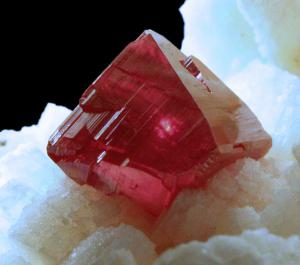 The Native Americans here in Evergreen would take note of the red soil and water contamination. They knew about the cinnabar before the Spanish came to colonize California.
The Native Americans here in Evergreen would take note of the red soil and water contamination. They knew about the cinnabar before the Spanish came to colonize California.
New Almaden Mines would date back to 1824. It’s name came from a combination of Arabic words “Al”, from, and “Maden”, the mine. Quicksilver would be cultivated at New Almaden then North Almaden in Evergreen. The largest producer would be Spain’s Alamden mines, or Old Almaden Mines. Quicksilver would be used in medicine and in the amalgamation of gold and silver ores as far back as the 16th century through furnaces and distillation.
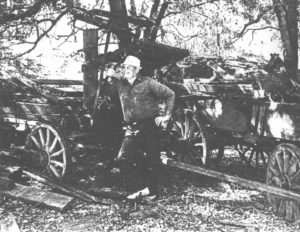 Only faint traces of the mines and mining culture can be found in Evergreen today. Here shown to the left is historian Richard Neiman, showing of some 100 year old mining equipment found at Blauer Ranch in the 1960’s. One half of Blauer Ranch would become the front portion of the Villages. The other would become the Silver Creek Valley Country Club.
Only faint traces of the mines and mining culture can be found in Evergreen today. Here shown to the left is historian Richard Neiman, showing of some 100 year old mining equipment found at Blauer Ranch in the 1960’s. One half of Blauer Ranch would become the front portion of the Villages. The other would become the Silver Creek Valley Country Club.
Mining creates a redundant theme in our Evergreen Mural Walk artwork. Here’s some of the Artwork with Mining overtones.

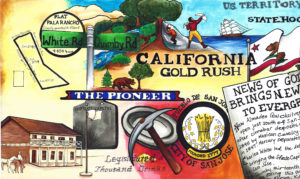
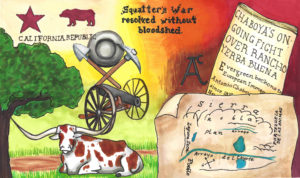
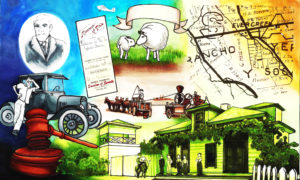
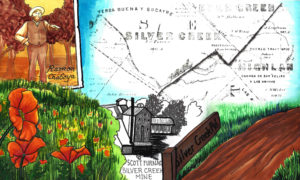
1 thought on “Redundant Theme – Mining for Evergreen”